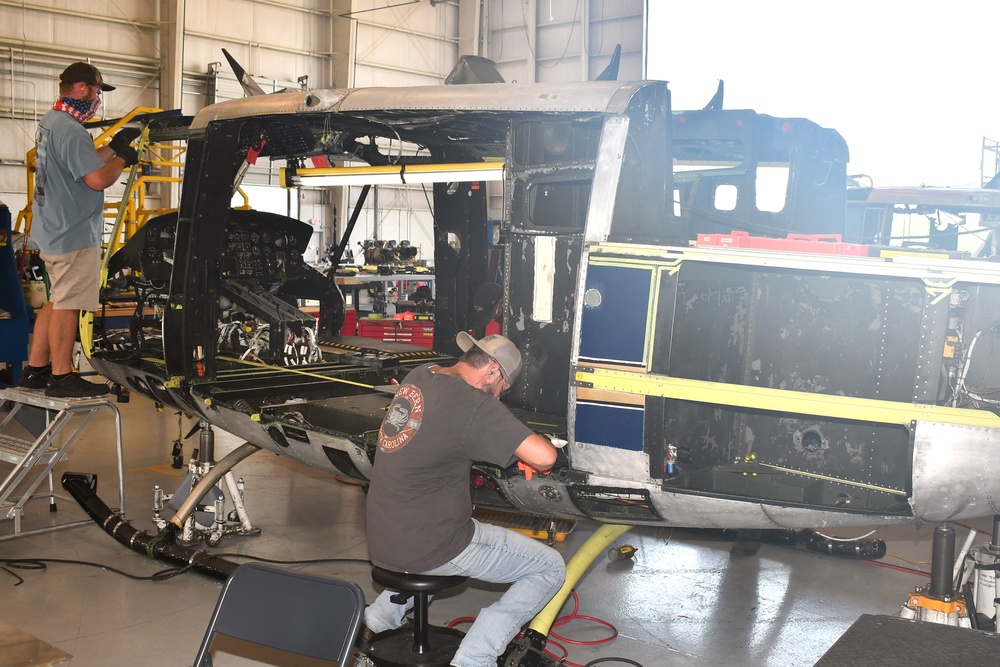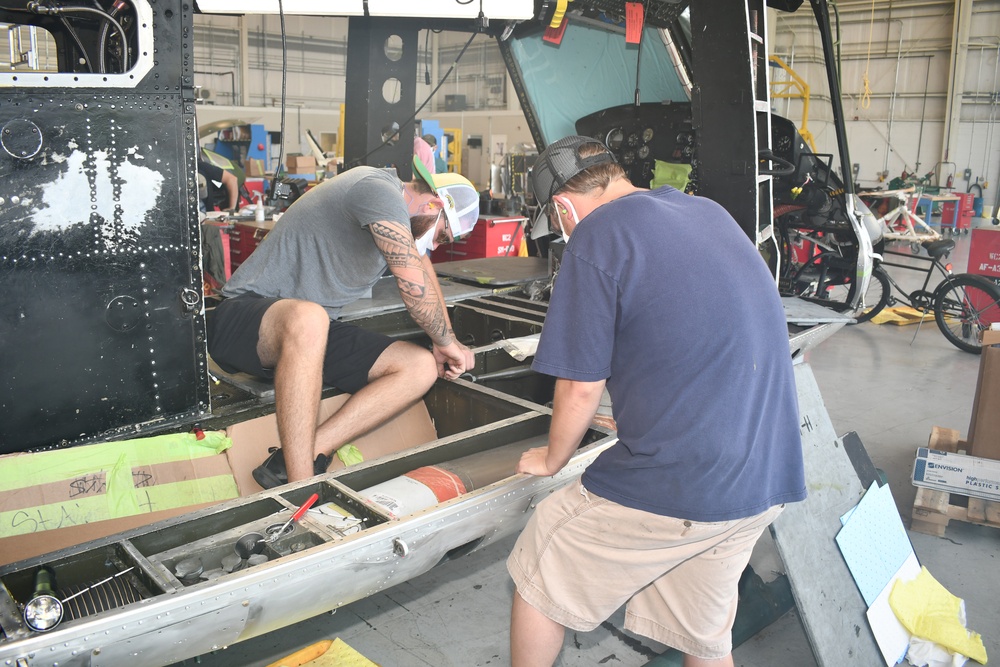Fleet Readiness Center East (FRCE) artisans recently completed work on the first UH-1N “Huey” helicopter to undergo service at the depot’s facility in Kinston’s North Carolina Global TransPark.

Logistical improvements brought about by the new location helped the team complete service on the aircraft more than 40 days ahead of the average turnaround times the H-1 line posted while based at FRCE’s primary facility at Marine Corps Air Station Cherry Point, said Allen Broadway, the H-1 branch head at FRCE. The Kinston location, which stood up in March, offers a dedicated space for the H-1 line while allowing the depot to reclaim hangar space at Cherry Point in support of the V-22 Osprey and H-53 heavy-lift helicopter programs.
The recently completed aircraft was in repair phase for 91 days, while the last six H-1 aircraft at FRCE averaged 130-140 days in repair. Broadway said he could attribute the improvement to many factors but, above all, the success lies in having all of the H-1 line’s logistical elements present in one place and the working partnership between FRCE and the Global TransPark.
“Our workforce has always had the skill to be able to do this,” he said. “However, having a dedicated warehouse for material, having the production controllers full-kit each repair with all the parts needed, and not having non-essential items stored in the shadow of the artisans – all of this makes a difference.
“One of the other things that contributed is that the team members at the Global TransPark have done a very good job of supporting our requirements,” Broadway continued. “They’re Johnny-on-the-spot for anything we need from facility modifications to essential services.”
Using these advantages to turn the H-1Ns quickly and get them back to the customer – the U.S. Air Force – makes a real-world impact in military aviation readiness, noted Matthew Pitts, the H-1 deputy branch head and test pilot. The H-1 is a Vietnam-era aircraft and the need for scheduled maintenance services remains high, as the Air Forces uses the helicopter for a wide variety of missions.
“In the grand scheme of things, every day we take off of repair here puts that bird back in the fleet that much sooner,” said Pitts, a former Marine Corps pilot. “That allows the customer’s readiness to go up, their training to go up and their pilot proficiency to increase. Decreasing these turnaround times is going to be a really big force multiplier for the Air Force.”
The UH-1N aircraft worked at the Kinston facility first arrive at Cherry Point, where artisans conduct an initial disassembly and route the aircraft through for cleaning and stripping. Artisans prepare the helicopter for transport via flatbed trailer to Kinston, where the H-1 team begins the repair phase. This phase is where the artisans are making noticeable gains in turnaround time.
The logistical improvements extend from operations in the hangar to testing on the flight line, Pitts said. Time savings in towing the aircraft to the flight line, fueling and coordinating airspace can combine to shave days off turnaround time, he said.

“From the flight side of things, we’re not competing for resources with the other aircraft lines,” Pitts explained. “We have shortened the wait times for the aircraft to get towed from the hangar and fueled by having a dedicated tug vehicle and fuel truck. The minutes saved during these evolutions add up to hours in the end.
“With this first flight operation at Global TransPark, I completed the flight in about 30 minutes and that included hover work, taking off, departing the airspace, making my runs, coming back, landing and shutting down. Previously, that same flight would have been an hour,” he continued. “I was able to complete testing on the aircraft in a matter of two days of flight, which could have been a four- or five-day evolution in the past.”
Travis Beamon, the line’s aircraft planner, said cross-training artisans to serve in other areas – including transportation – has also helped drive down turnaround times.
“For example, some of our artisans and production controllers are now trained and licensed to drive forklifts and tugs,” he said. “We can grab a qualified individual and say, ‘Hey, that bird needs to be towed,’ and they walk over, grab the tug and do it. Those types of time savings are hard to quantify, but it really helps with efficiency.”
Broadway said the logistical improvements at the Global TransPark location have also boosted employee morale.
“Things here are going very well,” he said. “The majority of the artisans seems to really like it here, which I think is also a positive part of the reduction in turnaround time – of course that helps.”
Pitts added that the smaller footprint has helped improve line integrity by creating a sense of teamwork.
“Everybody here has really started to come even closer as a family, and have a lot of pride in the line,” he said. “Sometimes you can feel disconnected when you’re somewhere as big as Cherry Point whereas here, on our own line, we see each other face to face every day.”
While the facility remains small compared to the primary depot in Cherry Point, it has grown since it stood up in March. The number of workers on the line has grown from 12 to just over 80 working across three shifts, with 50 of those being artisans, nine contract personnel, and the rest covering functions including administration, production control, aircraft evaluators, quality assurance and tool and parts attendants. Broadway said the line took a phased approach to moving from FRCE to Kinston, as there were still H-1 aircraft in the assembly and test phases at Cherry Point.
“We started out separating the numbers between the aircraft workers, the sheet metal mechanics, the electricians and so forth, but now we’ve been able to bring all those resources up here to the Global TransPark and we’re getting right-sized,” Broadway added. Most of the current workers came from FRCE, and a handful of new hires have helped round out the line.
The logistical elements involved in transitioning the UH-1N line from Cherry Point to Kinston were equivalent to deploying an organization equivalent to a Marine expeditionary unit, but the results have been worth the effort, said Gunnery Sgt. Christopher Manuel, FRCE’s H-1 military branch director.
“The amount of time and effort put forth by all parties to get Fleet Readiness Center’s operation at Global TransPark to the point of reducing turnaround time and returning the aircraft back to the fleet was absolutely remarkable to be part of,” Manuel said. “I’ve have completed an enormous amount of large-scale evolutions throughout my 20-plus years, and I have to say this transition has been one of the most rewarding experiences of my military career.”
Beamon said with the operation now in full swing, the H-1 team isn’t looking to slow down any time soon.
“We’re doing everything we can to drive that turnaround time down even further,” he said. “For every one aircraft that we’re sending back, there are sometimes two waiting to get in the door. If the aircraft doesn’t have hours available, then the pilot in the fleet is not getting hours. If the pilot’s not getting hours, then you no longer have qualified pilots. There’s a trickle-down effect, and it all starts here with us.”
That sense of ownership motivates the team to continually strive for improvement, Broadway added.
“This is our job, but it’s more than just that. It’s a way of life. It’s a very large motivator for our team to be able to look right out the hangar door and see their product literally fly away, and know they did that. It gives you a sense of pride and a sense of patriotism, as well. It’s a big deal.”
This press release was prepared and distributed by Fleet Readiness Center East.








